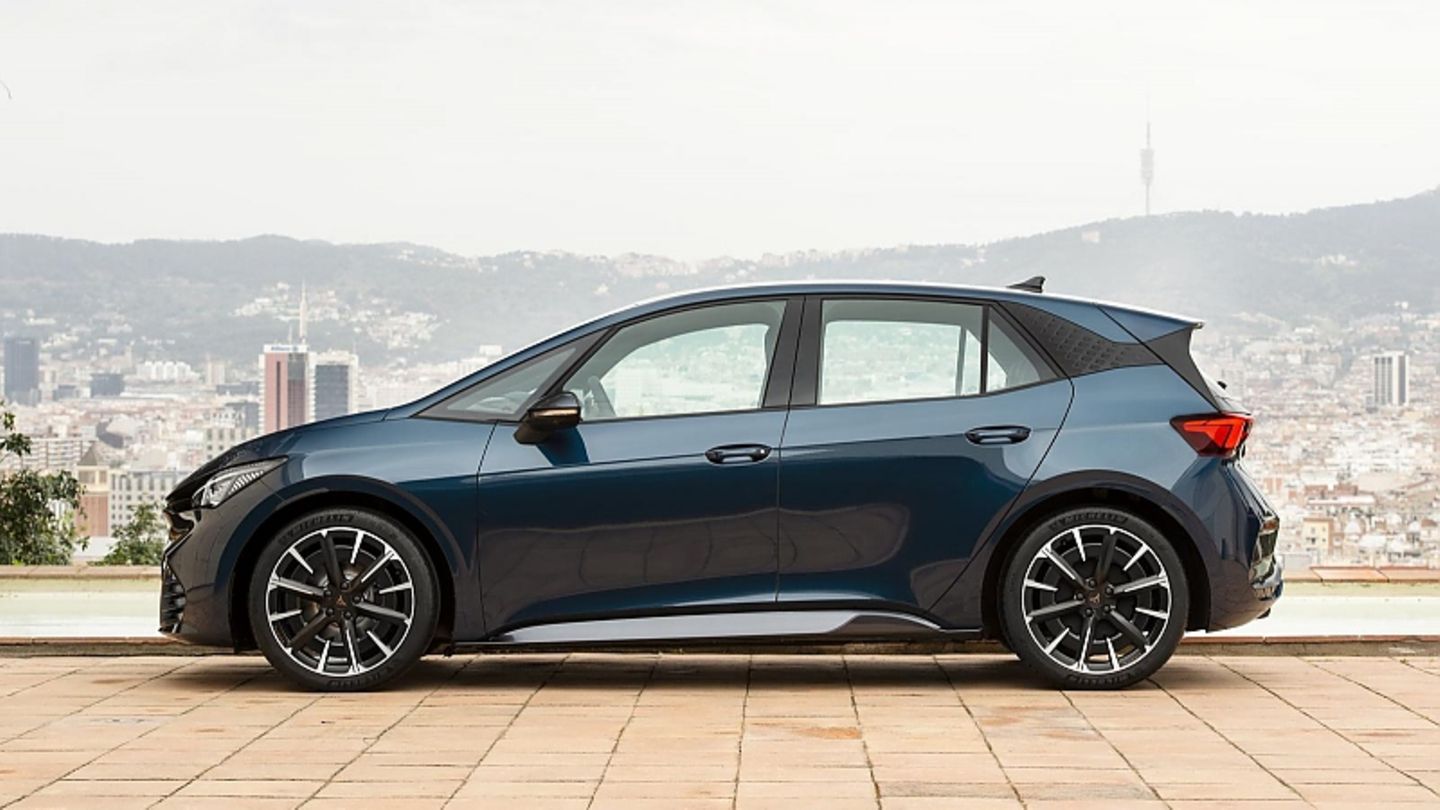With the Born, Seat’s noble offshoot Cupra enters the electric car market. It should convince with range and sportiness. That could work.
Under the body of the new Cupra Born there is the same technical basis as in the VW ID.3, ID.4, Audi Q4 e-tron or the Škoda Enyaq IV. All of these electric vehicles from the VW Group have been using it since 2015 developed “Modular Electric Drive Kit” (MEB). The Spaniard, which was developed in Martorell near Barcelona, is built together with the e-tron and the IDs in the German plant in Zwickau, which has been specially converted for the production of electric cars.
However, the Spaniards were not satisfied with just putting a copy on the tires. A few wishes could not be realized, one regrets at Cupra – for example a version with all-wheel drive. But where possible, they re-sharpened it in Matorell. The body design, for example, that they tailored around the MEB platform, is significantly sportier and more aggressive than that of the other group electric vehicles. In terms of dimensions, the Born roughly corresponds to those of the VW ID.3: 4,322 mm long, 1,809 mm wide and 1,537 mm high with a wheelbase of 2,767 mm. At the front, however, the body is lowered by 15 mm and at the rear by 10 mm. The Born looks much closer to the road than a normal SUV. And when it comes to tires, Cupra has not focused on pure energy saving, but rather on optics: In addition to the 215 mm wide tires, which are mounted on 18 or 20-inch rims, you can also order 235 mm wide tires.
In addition, Cupra ensures strong 3D effects on the body of the Born. The lush air inlets at the front should not only give it a sporty face, but also serve to cool the batteries and the drive train. The full LED headlights with the usual jagged daytime running lights are new. Side skirts, sharp fold lines that run the entire length of the body and the coupe-like curve of the roof to the rear spoiler are also responsible for the sporty look. At the rear, a lush diffuser and a light strip running across the entire width attract attention.
At first glance, nothing reveals that the Cupra Born is a purely electric car. And at second glance? Neither. Even the cover flap of the socket is located where the fuel tank cap is on a combustion engine. The impression of a perfectly normal compact crossover doesn’t change when you get in. There is even a “cardan tunnel” between the seats. It no longer has a technical function in electric cars – in the Born, however, it functions as a – lavish – storage space. Cupra has moved functional elements such as the gear selector lever to the side of the small but clear instrument cluster. It slipped onto the steering column and is clearly visible with every angle of the steering wheel. Next to it on the dashboard itself, as usual, the central, 12-inch touchscreen, via which infotainment and vehicle settings can be operated. An easy-to-read head-up display projects the most important information onto the windshield in front of the driver. The sports bucket seats at the front can be adjusted sufficiently far, are comfortable and offer great lateral support even on long journeys. The space in the back is customary for this class: Usually sufficient, but rather tight for tall drivers. A trunk with a volume of 385 liters opens behind the loading flap – around a quarter more than in a VW Golf, for example. There are plenty of assistance systems on offer, voice control, connection to smartphones, navigation, an app to manage and monitor the vehicle from the outside – the Born is state-of-the-art.
The aha moment comes while driving. Because the Born willingly delivers everything that makes an electric car so special today. That starts with the rest. But only at the start. No sound. Different when the Born starts moving: Wind and rolling noise from the tires – the bottom line is that the Born is only slightly quieter than a modern combustion engine, at least inside. But it goes off immediately when you press the gas (?) Pedal. As usual with the Stromer, there is no need to change gear – it pulls up from a standstill to a top speed of 160 km / h without interruption. The “small” battery enables an acceleration to 100 km / h in 7.0 seconds, with the more powerful battery 6.6 seconds are sufficient – a little faster than, for example, a Porsche Macan in the basic version. The electric motor with either 110 kW / 150 PS or 150 kW / 204 PS and 310 Nm torque from the first rotation acts on the rear axle. The permanent magnet synchronous motor runs at a maximum speed of 16,000 rpm. and is installed above the rear axle in front of the wheel center. The torque is transmitted via a single-speed gearbox with differential. There is an optional e-Boost package that pushes the engine output up to 170 kW / 231 PS for around 30 seconds.
In its base, the water-cooled lithium-ion battery in the vehicle floor has a capacity of 58 kWh, which, according to Cupra, is enough for a range of around 420 kilometers. A battery of up to 77 kWh is also available as an option. That brings a range of around 540 kilometers. On the way with the “large” battery, a range of 444 kilometers was displayed at the start. A few hours and around 200 kilometers later, the display was still just under 300 kilometers remaining – a sign that the recuperation is working perfectly. If you want, you can also drive the Born in a sporty way: pressing the Cupra button at the bottom right of the steering wheel immediately makes the accelerator more sensitive and the progressive steering much more direct.
The chassis uses McPherson struts at the front and a multi-link axle at the rear. The rear wheels have drum brakes, the front wheels disc brakes. The weight between the front and rear axles is almost perfectly distributed at 50:50. Since the batteries, which can weigh up to half a ton, are built into the bottom of the vehicle, the Born has a low center of gravity – which benefits the driving dynamics. In curves there is almost no tendency to roll, the Born pulls as if on rails.
The Cupra Born can already be ordered – at least in the basic version. This then costs from 37,220 euros. If you deduct the various grants, you should actually be there with 27,650 euros. The top model with 77 kWh batteries should be on the market in the first half of 2022.
I am a 24-year-old writer and journalist who has been working in the news industry for the past two years. I write primarily about market news, so if you’re looking for insights into what’s going on in the stock market or economic indicators, you’ve come to the right place. I also dabble in writing articles on lifestyle trends and pop culture news.




